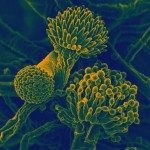Link to Pubmed [PMID] – 34154403
Link to DOI – e00531-2110.1128/mBio.00531-21
mBio 2021 Jun; 12(3): e0053121
Albumin is abundant in serum but is also excreted at mucosal surfaces and enters tissues when inflammation increases vascular permeability. Host-associated opportunistic pathogens encounter albumin during commensalism and when causing infections. Considering the ubiquitous presence of albumin, we investigated its role in the pathogenesis of infections with the model human fungal pathogen, Candida albicans. Albumin was introduced in various in vitro models that mimic different stages of systemic or mucosal candidiasis, where it reduced the ability of C. albicans to damage host cells. The amphipathic toxin candidalysin mediates necrotic host cell damage induced by C. albicans. Using cellular and biophysical assays, we determined that albumin functions by neutralizing candidalysin through hydrophobic interactions. We discovered that albumin, similarly, can neutralize a variety of fungal (α-amanitin), bacterial (streptolysin O and staurosporin), and insect (melittin) hydrophobic toxins. These data suggest albumin as a defense mechanism against toxins, which can play a role in the pathogenesis of microbial infections. IMPORTANCE Albumin is the most abundant serum protein in humans. During inflammation, serum albumin levels decrease drastically, and low albumin levels are associated with poor patient outcome. Thus, albumin may have specific functions during infection. Here, we describe the ability of albumin to neutralize hydrophobic microbial toxins. We show that albumin can protect against damage induced by the pathogenic yeast C. albicans by neutralizing its cytolytic toxin candidalysin. These findings suggest that albumin is a toxin-neutralizing protein that may play a role during infections with toxin-producing microorganisms.

